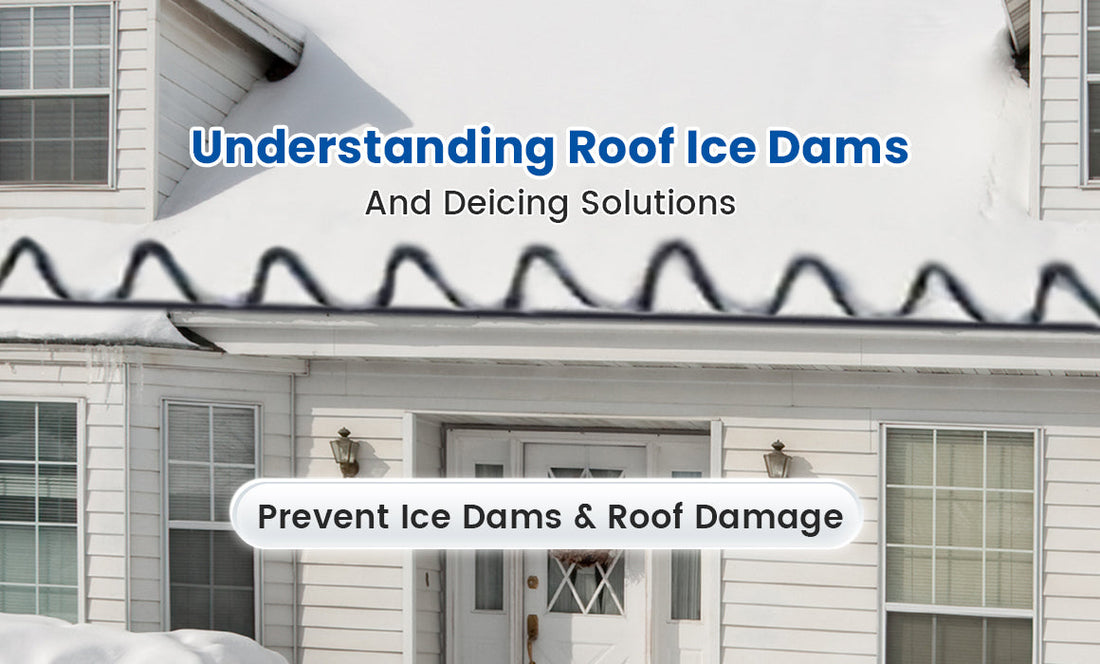Winter brings beautiful snowy landscapes, but it also poses a significant threat to homeowners: ice dams. These ice blockages can lead to severe roof damage and expensive repairs if not addressed promptly. One effective solution to prevent these issues is the installation of roof deicing cables.
This blog explores the causes of ice dams, the functioning of roof deicing cables, the benefits of installing them, and the differences between constant wattage and self-regulating heating cables.
How Ice Dams Form and the Damage They Cause
Ice dams form when the snow on your roof melts due to heat escaping from your home, then refreezes at the roof's edges where temperatures are colder. This cycle creates a ridge of ice that prevents further melting snow from draining properly. As water accumulates behind the ice dam, it can seep under shingles, damaging your roof, walls, ceilings, and insulation, and potentially leading to mold growth. The damage can be extensive, often requiring costly repairs.

Traditional methods like manual snow removal are not only labor-intensive but also risky. Modern solutions like roof deicing cables offer a safer and more efficient way to manage this issue, ensuring that your home remains protected throughout winter.
How Roof Deicing Cables Work
Roof deicing cables, also known as heat tapes, are installed along the edges of your roof and in gutters to prevent ice dams from forming. These cables generate heat when plugged into a power source or activated by a temperature-sensitive controller. The heat from the cables melts snow and ice around them, creating a path for water to flow freely off your roof, thus preventing the buildup that leads to ice dams. It's important to note that while deicing cables won't clear all snow from your roof, they create enough melting to keep water moving, protecting your roof's structure.
Benefits of Installing Roof Deicing Cable Systems
Installing roof deicing cables provides several advantages that go beyond simply preventing ice dams:
1. Prevents Costly Damage: By stopping the formation of ice dams, deicing cables help protect your roof, gutters, and interior spaces from water damage, which can save you from expensive repairs and maintenance.
2. Extends Roof Lifespan: Continuous freeze-thaw cycles can wear down roofing materials over time. Deicing cables reduce the strain on your roof, helping it last longer.
3. Enhances Safety: Icicles and falling ice can pose hazards to people below. Deicing cables minimize the formation of these dangerous conditions, keeping your home's surroundings safe.
4. Easy Installation: Roof deicing systems can often be installed without major modifications to your existing roof structure, making them a straightforward solution for most homes.
5. Cost-Effective: No matter which heating cable you choose, the expense is far lower compared to costly repair bills. Installing self-regulating cables or corresponding temperature controllers will further enhance energy savings and reduce overall costs.
Constant Wattage vs. Self-Regulating Heating Cables
When choosing a roof deicing system, it's essential to understand the two main types of heating cables: constant wattage and self-regulating. Each has its own set of benefits and considerations.
Constant Wattage Cables:
● Advantages: These cables deliver a steady heat output regardless of the ambient temperature. They are reliable and straightforward, providing consistent performance in a wide range of conditions.
● Disadvantages: Because they operate at a fixed power level, they may use more energy than necessary, especially when temperatures are milder. This can lead to higher energy costs.
Self-Regulating Cables:
● Advantages: Self-regulating cables adjust their power output based on the surrounding temperature, reducing their heat as the temperature rises. This feature not only enhances energy efficiency but also extends the lifespan of the cables since they are not operating at full power constantly.
● Disadvantages: Self-regulating cables are generally more expensive upfront compared to constant wattage options, and their installation may be slightly more complex.
Overall, self-regulating cables offer a more energy-efficient and adaptable solution, particularly for regions with variable winter temperatures. The added cost can be offset by energy savings and reduced wear on the cables over time.
Conclusion
Roof deicing cables are an effective way to safeguard your home against the damaging effects of ice dams. By understanding how these systems work and the differences between constant wattage and self-regulating cables, you can make an informed decision that best suits your needs. Whether you're looking to prevent costly repairs, extend the life of your roof, or simply enhance safety during winter, investing in a deicing cable system is a smart and practical solution.



